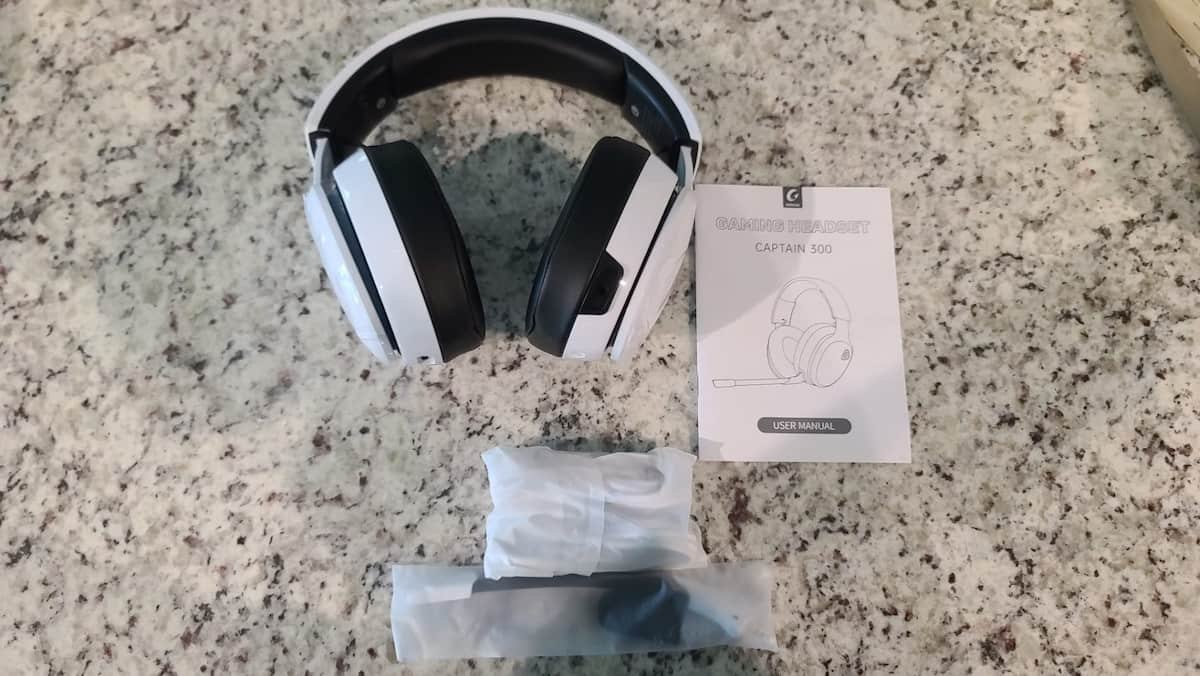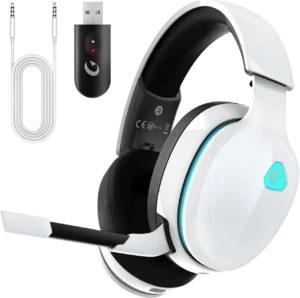I didn’t plan to review another wireless headset this month, especially not one with “Captain” in the name and big glowing lights on each side. It felt like one of those accessories you’d find lost in a pile at a supermarket tech aisle—something that tries to look like a spaceship to distract you from what it lacks under the hood. But then I saw the triple connection modes: wireless 2.4GHz, Bluetooth, and even a regular 3.5mm jack. And it was cheap—way too cheap for all that. So I figured, fine. Let’s see what it can actually do.
I cleared off the usual testing spot, boxed up my daily driver headset, and gave the Captain 300 a full 12-day run. Not a review unit, no “for testing purposes” agreement—just me, this headset, and the kind of daily grind that can break a weak design in two days. Long calls, long games, background music while editing, YouTube wormholes before bed. No break. No swaps. If it failed, I’d feel it immediately. If it surprised me, even better.
First Impressions – A Glossy Tank with No Apologies
It’s not subtle. I opened the box and immediately saw those glossy, mirror-like earcups staring back at me like two rounded pieces of dark candy. Fingerprint magnets? Absolutely. But they looked clean, and when I picked it up, it had a certain heft I wasn’t expecting at this price. Not heavy, but definitely not hollow.

Inside the box, you get the headset, a detachable mic, USB-C charging cable, a USB dongle for wireless use, and a short 3.5mm aux cable. Nothing feels cheap in the hand. The cables are thick and rubberized. The joints don’t squeak when you twist the headband open. Even the mic, which is usually the weak point on these affordable sets, has a nice resistance to it when you bend it into position. I was already raising an eyebrow.
Still, none of that really matters if the headset doesn’t sit right. So I threw it on, and the first thing I noticed was the clamp. It’s tight out of the box—maybe too tight if your head is larger than average. But the cushions are soft, and the headband has just enough flex that I didn’t feel pinched. I wore it through a full afternoon of writing and didn’t need to adjust it once. No shifting. No creeping. It stayed exactly where it started.
Sound Check – The First Games Tell You Everything
I always run the same few games when testing audio—one battle royale, one shooter with tight positional cues, and one single-player title with big cinematic sound. I started with the most chaotic one: a fast-paced, bullet-filled map with three different directions of incoming fire. And right away, I knew this headset wasn’t just “working”—it was actually helping.

Footsteps were clear. Not exaggerated or hollow, just clean and right where they needed to be. Gunfire didn’t blur into the background. Explosions hit with a kind of soft thud that didn’t shake my brain, but still felt satisfying. Voices from teammates came through with a crispness that surprised me, especially considering I was still in wireless mode. I didn’t even touch any EQs or settings. I just plugged the dongle into the back of the console and it worked—seamlessly.
The most impressive part wasn’t the volume or the bass—it was how consistent everything felt. There were no random dips, no weird distortions when action got heavy, and no static when I turned my head. That’s rare. Especially on a headset where half the cost probably went into just making the lights look cool.
Music, Background Noise, and Passive Isolation
Once the gaming sessions were done for the night, I switched gears. I like to write with lo-fi or ambient playlists running in the background, and this headset stayed on for hours without a problem. The seal around the ears is pretty good—not noise-cancelling good, but enough to keep the hum of my desk fan and the clink of dishes in the kitchen from pulling me out of focus. The padding doesn’t overheat either, which I appreciated more than I realized until I swapped back to an older pair one morning and immediately felt the sweat build-up.

Sound-wise, the Captain 300 leans slightly bass-heavy when you’re listening to music, but not in a boomy, messy way. It’s a soft lift in the low end that actually works really well with chill beats and most mainstream stuff. Vocals sit a little further back in the mix, but they don’t get lost. I never felt like I was fighting the headset to enjoy music. And that’s important. Some headsets try too hard to impress with thump and lose all clarity. This one doesn’t.
I even watched a full movie with it one evening—nothing fancy, just a late-night thriller with heavy dialogue and a few loud chase scenes—and the audio held up from start to finish. I never had to rewind because I missed what someone said. That’s rare. Usually with these budget pairs, you either get muffled voices or flat, unbalanced sound. This one stayed composed.
Microphone – Clearer Than It Should Be
Let’s talk about the mic. It’s detachable, flexible, and actually works better than I expected. I used it for three long Discord calls and two Zoom meetings while testing. Everyone could hear me clearly, and no one asked if I was using a headset mic—which is usually the first sign something’s off. I didn’t apply filters or adjust input gain. Just plugged it in and started talking.

The boom holds position well. It doesn’t sag or wobble like the cheap ones do. And when you’re done with it, you just pull it out. I like that. You don’t need it flopping around when you’re using the headset for media or music.
One thing I noticed: if you’re in a room with lots of background noise—TV in another corner, people talking—the mic still manages to prioritize your voice. Not perfectly, but enough to avoid frustration. That makes it usable in real-world homes, not just quiet setups.
Wireless, Bluetooth, and Wired – Switching Around
I didn’t expect this headset to be as flexible as it is. Wireless mode through the dongle was my default for console and PC use. It connects instantly, no sync issues. I moved about five meters away, left the room once, and it didn’t drop signal. That alone is a small victory.

Bluetooth mode was for music from my phone. One long press and it pairs like any other wireless headphones. Sound quality drops just a touch in Bluetooth—less detail, softer high end—but that’s standard. And when I needed to go fully wired, I just plugged in the aux cable and kept going. I didn’t need to turn it off or switch modes. It just worked.
Switching between devices isn’t instant—you’ll want to disconnect one before jumping to the next—but I didn’t find it annoying. If you’re only jumping between, say, your console and phone, this is about as smooth as it gets in this price range.
Battery Life – A Welcome Surprise
I charged it once at the start and forgot about it. No joke. I went five straight evenings of gaming and music before I saw the red blinking light. That’s with the RGB lights off. With them on, the battery drains faster—but I turned them off on day two. Not because they were bad, but because I just didn’t care for flashing rings on the sides of my head while writing at midnight.
Charging takes a bit under three hours through USB-C. And once it’s full, you’re good for well over a full week of casual use. I like that I didn’t have to babysit it. There’s no voice prompt when the battery gets low—just a blinking light—but that’s enough.
Quirks, Mild Annoyances, and Everyday Reality
It’s not perfect. The glossy finish looks nice for about an hour, then smudges show up. The volume wheel could be a bit stiffer—I bumped it twice by accident reaching for something on my desk. And it definitely clamps a bit tight if your head is on the larger side. After a week it eased up a little, but the first few days took some adjusting.
Also, the lack of onboard mute for the mic means you have to use your device’s software or flip the boom up, which mutes it physically but doesn’t give you feedback. It’s not a huge issue, but if you’re used to dedicated mute buttons, you’ll notice.
Still, none of these things ever made me want to stop using it. And that says a lot.
Who Actually Needs a Captain 300
This is for the gamer who wants versatility. Someone who plays on multiple platforms, listens to music on their phone, watches movies on a laptop, and needs just one headset that can do all of that without asking for too much in return. It’s not flashy once the lights are off. It doesn’t scream premium. But it works. Day after day, hour after hour, it works.

And when you pause and think about how many headsets at this price point fall apart after two weeks—or start sounding like you’re underwater—that’s worth a lot.
Final Thoughts – Not a Placeholder, a Daily Option
I didn’t expect to enjoy using this headset. I expected to find reasons to stop using it halfway through the review period. Instead, it held up. Every game, every call, every playlist. It just kept delivering.
This isn’t one of those reviews where I hand the headset off to a family member and move on. This one’s staying nearby. Maybe not front and center on my setup, but hanging on the side arm of my desk for the nights I need wireless freedom or a backup pair that doesn’t make me miss the main one. For the price, that’s the highest praise I can give it.
Captain 300 Gaming Headset

The Captain 300 Gaming Headset delivers immersive wireless audio with 2.4 GHz and Bluetooth 5.2 connectivity, noise-cancelling mic, RGB lighting, and long battery life (up to 40 hrs). Ideal for multi-platform use including PC, PS5, Switch, and mobile.
Product SKU: CAP300
Product Brand: Gtheos
Product Currency: USD
Product Price: 30.59
Price Valid Until: 2030-12-31
Product In-Stock: InStock
4.3
The Captain 300 is available on Amazon.